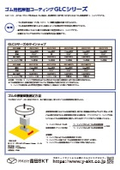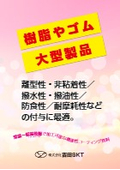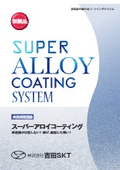Surface treatment technology that can be applied to the surface of rubber.
[Presentation of Materials] We will introduce the advantages and disadvantages of rubber materials, as well as what can be improved through surface treatment.
Rubber is an essential material in our daily lives. It is used in various situations, not only in household goods but also in automotive parts, PC components, the chemical industry, and the medical field. Unlike resins and metals, rubber has elasticity. Additionally, it excels in waterproofing, cushioning, vibration absorption, and tackiness, making it beneficial for applications such as tires, sealing materials, rubber gloves, rubber hoses, roofing materials, and soundproofing materials. On the other hand, rubber has its disadvantages, such as dissolving in solvents, hardening due to ultraviolet rays or aging, and having a surface that can be slippery. Surface treatment of rubber can help improve these disadvantages. For example, by applying surface treatment to non-slip rubber, it can become easier to handle, facilitating installation and preventing sticking, thus enhancing convenience. It can also be protected from dissolving in certain solvents. Surface treatment of rubber requires confirmation of various conditions. For more details, please download the PDF or contact us.
basic information
Super Alloy Coating is a coating system that covers the surfaces of soft substrates such as plastics and rubber, as well as lightweight metals like aluminum and thin sheets, with an alloy that has a hardness of Hv 600 or higher, while also possessing flexibility. It effectively prevents dirt on various manufacturing equipment and components, reduces maintenance tasks such as the peeling of adhesives, and exhibits excellent mechanical strength and durability. The unevenness of the coating is rounded, which minimizes scratches on contact objects. Additionally, despite being a metal coating, it has the ability to conform to slight bending and can accommodate curved surfaces. It allows for excellent release properties from adhesives and strength while maintaining the flexibility of the processed materials. 【Features】 ■ Non-stick convex surface coating ■ Alloy coating with Hv hardness of 600 ■ Excellent mechanical strength and durability ■ Reduces scratches on contact objects ■ Can be processed into various materials 【Lineup】 ■ Plastic and rubber processing series ・Silicone-based (processing temperature RT to 80°C) ・Fluorine-based (processing temperature 130 to 180°C) ■ Heat-resistant substrate processing series ・Fluorine-based (processing temperature 300 to 400°C) *For more details, please refer to the PDF document or feel free to contact us.
Price range
Delivery Time
Applications/Examples of results
【Applications】 ■ Sponge press rolls ■ Plastic drive components ■ Rubber rolls for conveying ■ Wear resistance of resin belts, etc. *For more details, please refer to the PDF document or feel free to contact us.
Related Videos
catalog(4)
Download All Catalogs


News about this product(1)
Recommended products
Distributors
To maximize the performance of manufacturing equipment and machine parts, Yoshida SKT derives the "optimal solution" tailored to our customers from hundreds of surface treatment technologies. - Decreased productivity due to adhesive troubles - Instability in product quality due to friction - Early deterioration of equipment due to corrosion We respond to these challenges in the manufacturing field with our extensive track record and reliable technical expertise. In 1963, we began fluoropolymer processing. In 1968, we signed a licensing agreement with DuPont (now Chemours), supporting manufacturing innovations for over 2,000 customers across various industries, from automotive to medical and aerospace. Furthermore, in 2024, we are focusing on the development of next-generation products, such as PFAS-free coatings, contributing to the advancement of sustainable manufacturing. With a three-base system in Nagoya, Tokyo, and Yamaguchi, we flexibly respond to both mass production and custom orders. Our consistent quality management system ensures that we deliver reliable quality. For solving challenges in the manufacturing field, trust the surface treatment experts at Yoshida SKT.










































